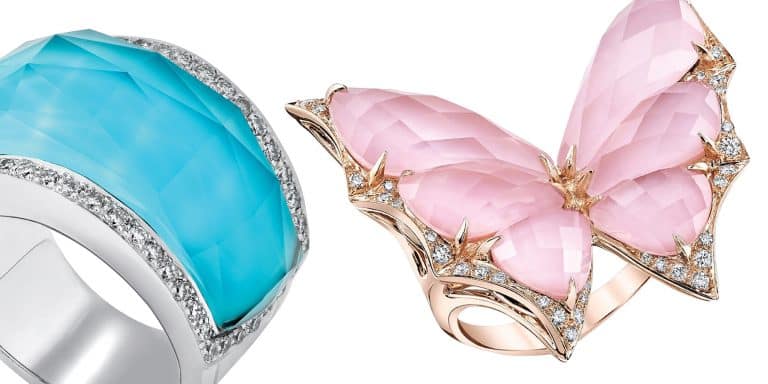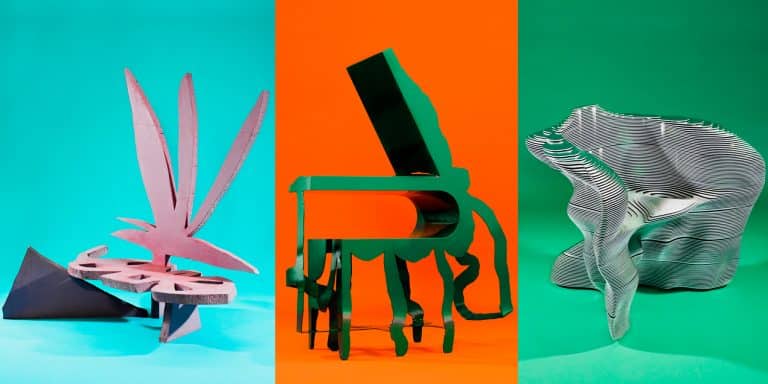
November 2, 2011Fiona Druckenmiller’s personal jewelry choices are dramatic but restrained. Top: The FD storefront on Manhattan’s Upper East Side often has lively window displays.
A zenlike calm pervades FD, Fiona Druckenmiller’s year-old store on East 65th Street. The precisely edited cases display expertly crafted pieces, many of them vintage, all of them exquisite, from Verdura, Van Cleef & Arpels and Cartier, as well as modern creations from Hemmerle and Viren Bhagat. There are also enticing objets and bold, graphic works of art. Suffice it to say, without belaboring the point, the stuff is jaw-dropping.
But Druckenmiller, who has long, very full, blond hair and perfect posture, is not one to wax on about its preciousness. “My feeling is that jewelry is a luxury, but it shouldn’t be taken seriously,” she says, her tiny frame outfitted in a skinny floral dress and black leather jacket. Her personal jewelry selection today is dramatic but restrained: no necklace, no bracelet, no earrings. Just three rings: a large Colombian emerald next to a thread-thin diamond band on one hand, and a knockout Hemmerle sapphire set in copper on the other.
“It’s kind of the anti-bling,” she says of Hemmerle, which she has been collecting since first seeing an ad for the Munich-based brand six or seven years ago. “They’ll set a diamond in iron. They tend to be bold pieces. I find them urban. They work well in New York.”
Druckenmiller’s idea of luxury is one-of-a-kind, or at least a very limited edition, whether vintage or new. “We try to tell a story in the cases,” she says. There might be an Art Deco group, a cache of Hermès minaudières or a clutch of Schlumberger cigarette lighters. But Druckenmiller insists not everything is priceless. “We want everyone to feel comfortable here,” she says, noting that items start at $25.
There are photographs by Man Ray and works by Robert Longo, special baby gifts and charming objets like silver animals to graze on your dining table. FD also commissions one-off silver pieces on behalf of clients; one customer, a dedicated hunter, recently ordered a pride of lions surrounding a water-buffalo kill. In the back of the shop, berries and sweets have been set out across from classic children’s books and volumes of art.

The precisely edited display cases feature expertly crafted jewelry.

Among the jaw-dropping pieces in the FD shop are (clockwise from top left) an 18-karat gold Bulgari peacock enamel ruby serpent bracelet watch, 1970; an old Colombian buff-top emerald and diamond ring, by Viren Bhagat; a multi-gem and gold horse brooch by René Boivin; a Cartier diamond and onyx panther ring; a Mauboussin ruby, turquoise, diamond and gold bracelet.
If the mix of offerings and overall atmosphere within FD are wonderfully unique, that’s because Druckenmiller comes to the retail business with an interestingly varied background. She began her career on Wall Street, where she rose to become the first female portfolio manager at Dreyfus. After giving birth to her first daughter (she’s married to hedge-fund manager Stanley Druckenmiller), she reduced her office time to two days a week. “I was lucky — I had a boss who was a hippie,” she says with a small smile. With daughter number two, she cut it down to one day, and after the arrival of her third daughter, she agreed to come in just four hours a week while continuing to manage $500 million in assets and running the international research department. “I was feeling stretched,” she says, sounding like a master of understatement.
She resigned and turned her attention to board work, from the American Museum of Natural History to the Parrish Art Museum. (She and her husband have earned a reputation for philanthropy; their foundation gives primarily to medical research, education and efforts to fight poverty.) In an apparent about-face from her Dreyfus days, she also returned to school, became ordained as an interfaith Reverend and began counseling seriously ill patients in a doctor’s office. “It’s very fulfilling work,” she says. “I saw a lot of important results.”
Druckenmiller worked with patients for more than a decade, but stopped a few years ago, drained from the intense experience. As a longtime jewelry collector, and with her daughters now all in college, Druckenmiller decided to open FD. She drew about a quarter of the initial inventory from her own trove. The idea, she says, was to curate a selection of “anything that’s beautiful and limited and not available in a department store. You’re not going to run into someone on the street wearing it.”

The shop’s salon-like setting.

Another view of FD’s decorative street-facing window
While the store itself is exquisite, Druckenmiller relies heavily on FD’s website, which she has discovered serves as a calling card for many new clients. “The whole Information Age has changed the landscape so much,” she says. “Probably a good one-third of our sales are from customers who don’t come into the store.” Another undertaking was an entire digital strategy. Everyone on staff carries an iPad for instant access to inventory in case, for instance, a client is searching for a coral piece not on display, or perhaps rubellite earrings.
Her game plan is clearly international. She recently returned from Hong Kong, where she exhibited her wares at the Fine Art Asia show. The experience gave Druckenmiller new insight into the Asian market. For one thing, women seem unusually enamored of brooches. For another, “they know Cartier. They do not know a lot of other designers Americans would know,” she says. At the same time, one of her colleagues was amazed to see a velvet rope in front of the Chanel boutique, where would-be shoppers were forced to queue for a turn inside.
Druckenmiller sources the jewelry from auctions and in private. “A lot of it is ending up with the right estates,” she says, noting that two of the three pairs of JAR earrings she obtained — a real coup — and sold over the summer were from an estate. While such coveted items may have once ended up dangling from her own ears, now, she says, “I don’t need anything, so if I can get something special and priced well, it’s for the store.”
Her personal taste runs toward the simple, and she likes to mix it up. “I’m not into matchy-matchy,” she says. “I will wear something new with something old, one designer with another.”
As for the modern trend of women buying for themselves, rather than waiting for what she calls “husband jewelry,” Druckenmiller is an enthusiastic proponent. She describes her own spouse as “very lenient and understanding” about her passion, if not “terribly interested” in the subject himself. She didn’t rely on his gifts to build her substantial collection: “He’s a very generous man,” she says with a soft laugh, “but Mother’s Day was often a great book.”


